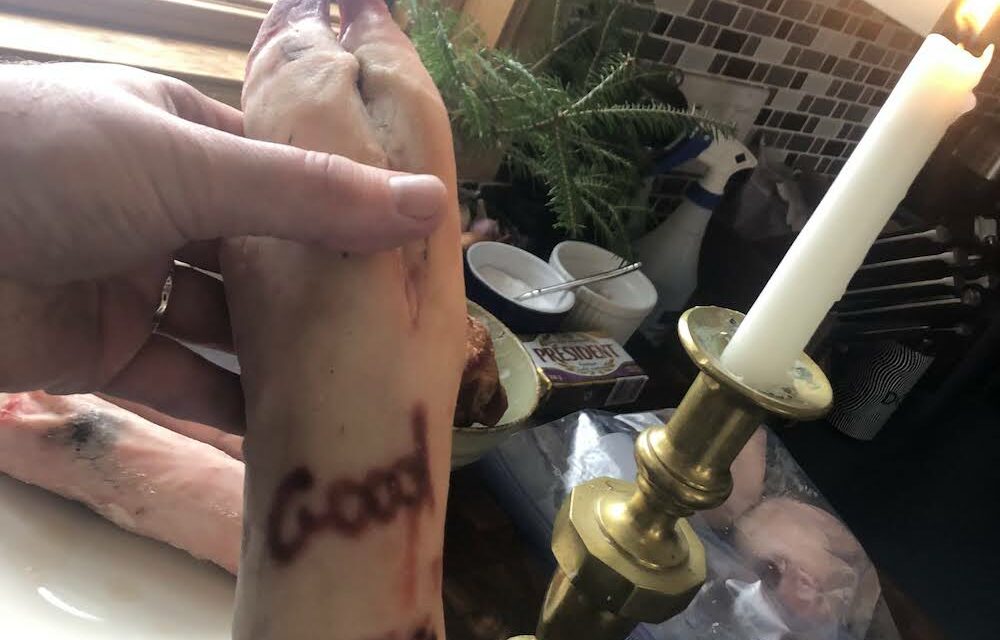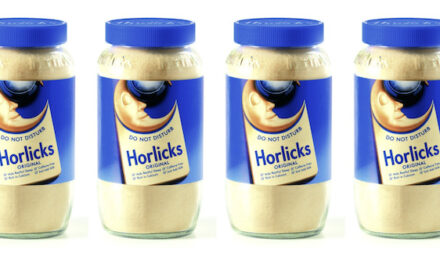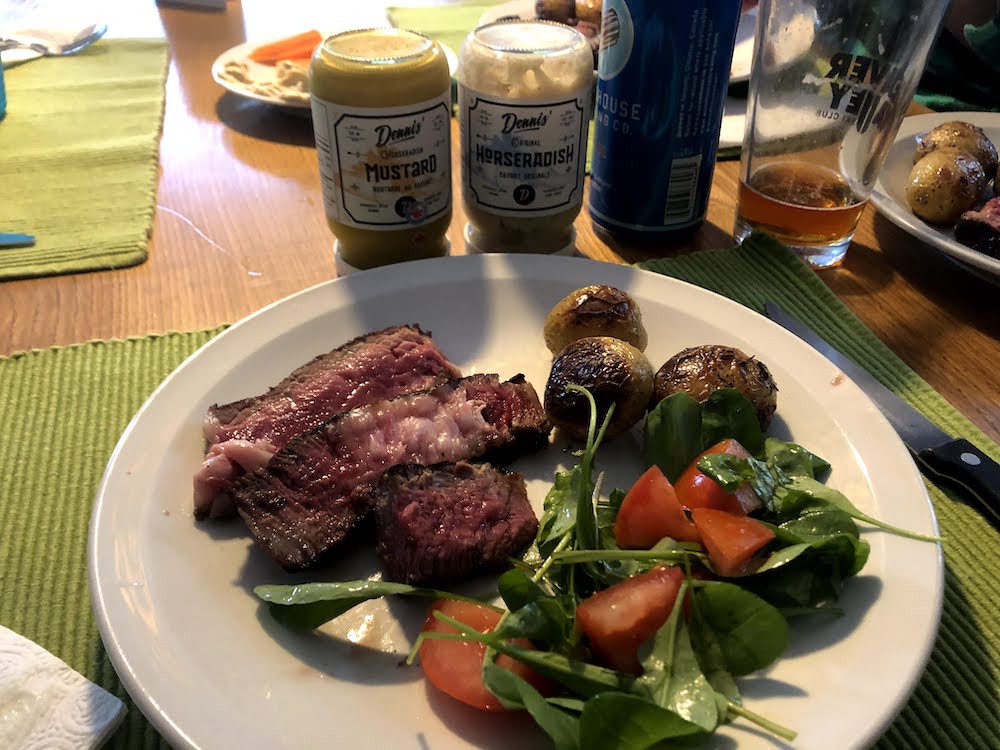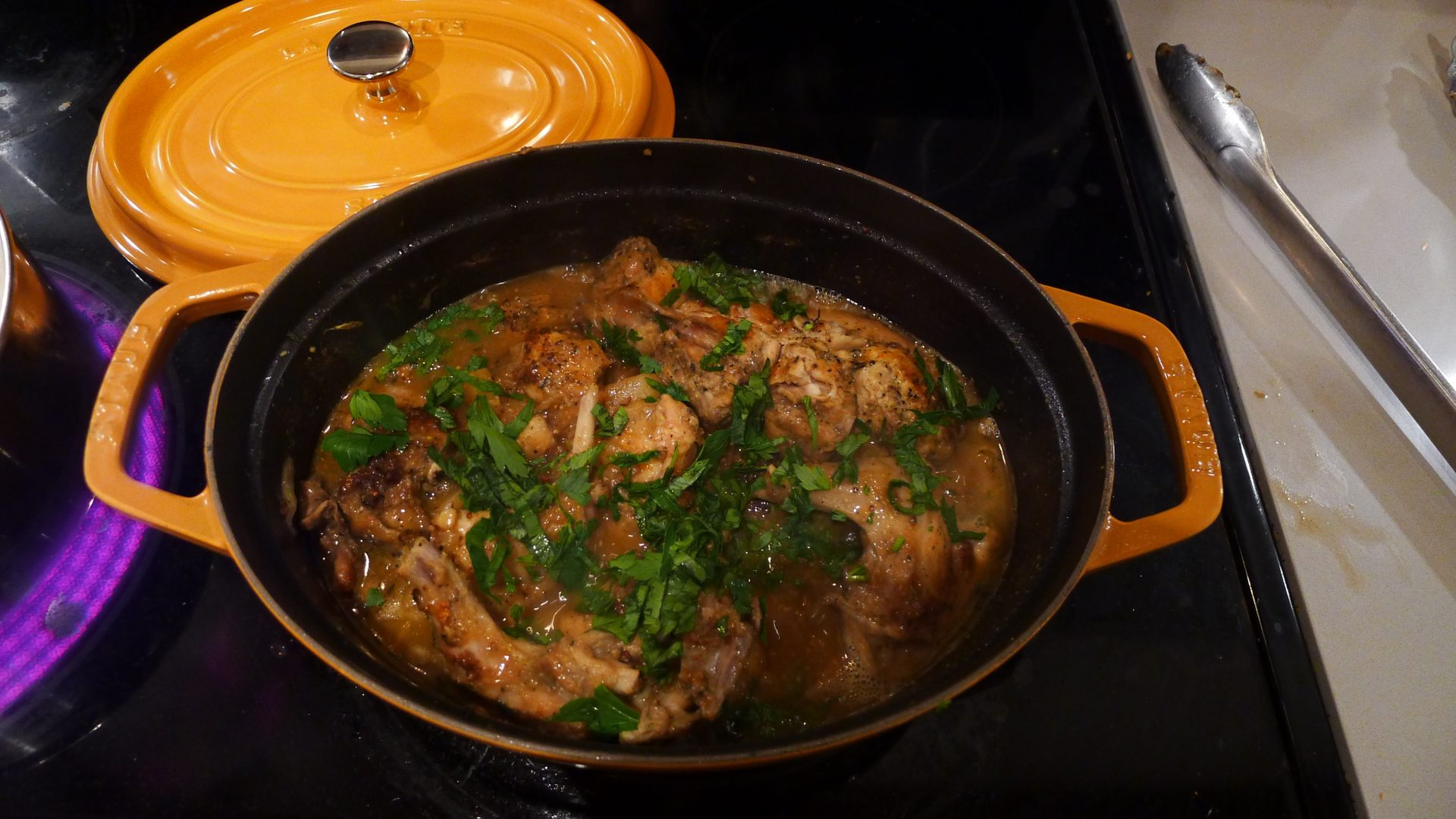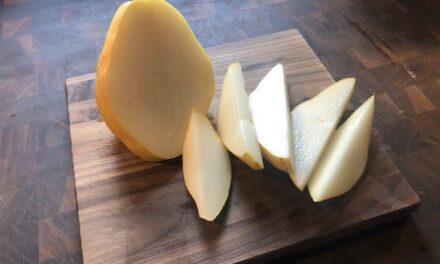Before we begin, a word of advice regarding the preparation and serving of a dish containing pig’s trotters:
Do NOT show your family the hairy, bristly, uncooked trotters beforehand, and certainly don’t let them experience the aromatic “delight” of you singeing off said bristles with a naked flame.
I made this beginner’s mistake and now my wife simply refuses to go anywhere near what I consider to be an utterly delicious rustic dish; I honestly think that she has been somewhat traumatised by both the visual and olfactory stimulation offered up here, and now feel rather guilty about the whole episode.
Saying that, our gourmand-to-be eight year old son, thoroughly enjoyed the palpable visceralities of the prep, making him all the more enamoured of the resultant dish; that’s my boy!
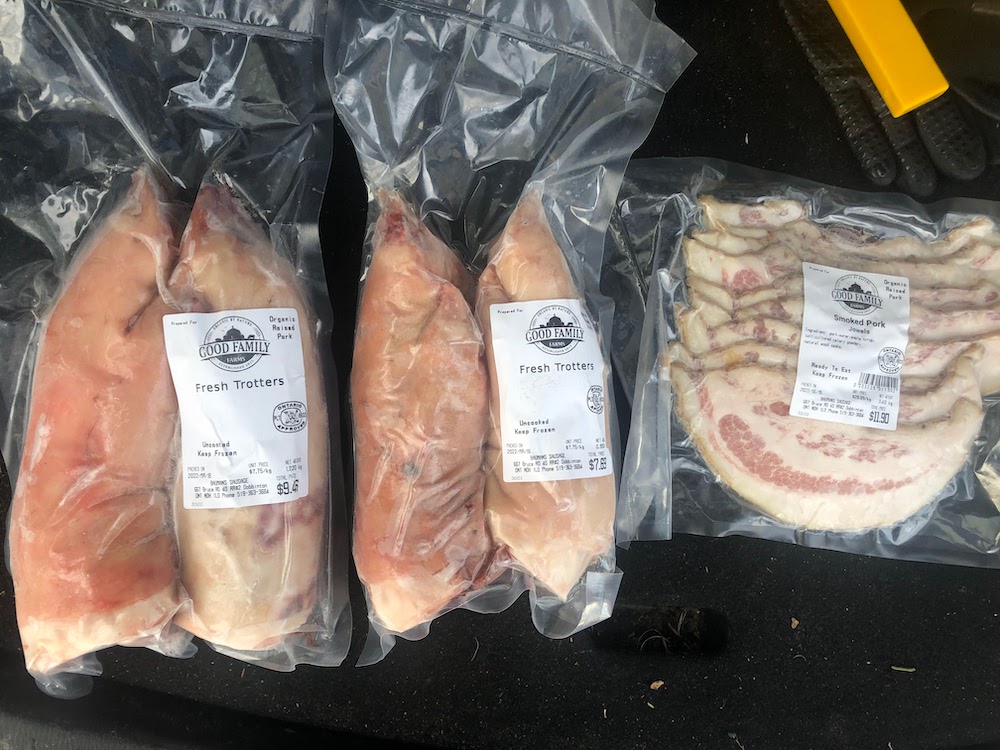
So, I had this idea of cooking a Quebecois Réveillon de Noël menu, replete with tourtière and something involving both beans and pig’s trotters.
It took me a wee while to track down some trotters, but I eventually sourced them from Good Family Farms near Meaford. This particular farm was new to me, but I’m sure I’ll be back there again soon as they had a superb selection of meats. As well as four large trotters I picked up a smoked ham hock and some absolutely bloody gorgeous Jowel Bacon, all frozen.
I was rather excited with my haul, but in typical hyperthymic fashion felt the need to add to it, just a little, and hence I purchased another unsmoked hock from the supermarket later that day.
Upon my return to the homestead I proudly displayed my various pig bits to my family, laying them all out on the cutting board so as I could work out my plan of attack, as I was still actually rather unsure as to what I was going to make, and to slightly defrost the trotters.
Our son was as curious as ever, studying the trotters carefully, pointing out the hairy knuckles, and the mysterious detritus hidden betwixt the piggy toes; his mother was far less impressed with the thawing porcine appendages, particularly after hearing me inform our son that I would have to sear the bristles off before cooking them.
I remembered that my old pal Fergus Henderson had a decent recipe for pig’s trotters, turning them into something he called “Trotter Gear”.
Okay, so Trotter Gear would be the order of the day, and I’d mix them into some cannellini beans I had part-cooked earlier.
When I say “some” it was actually two bags, so more beans than any sane person could possibly eat in a month (see below).
I was certainly going to need a bigger boat pot.
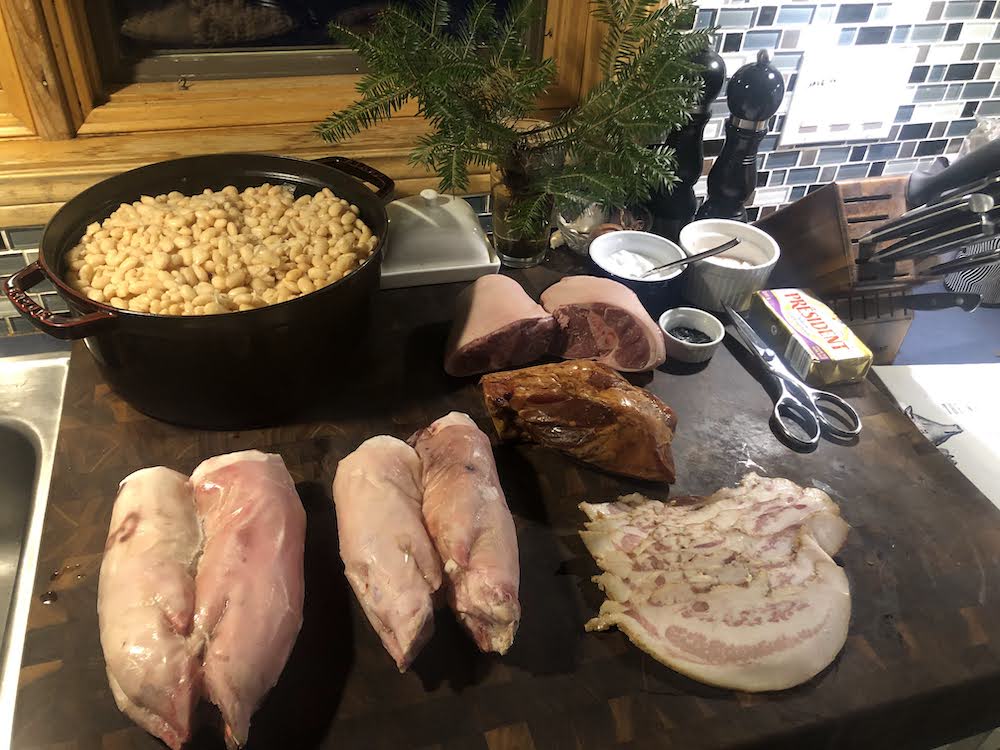
First things first, burn off those bristles.
Pat the trotters completely dry before doing this, and be ready to fill the kitchen with the curious aromatics of incinerated hog stubble. In a perfect world one would have a small blowtorch at hand for this job, but a few matches can do the job in a pinch, just be sure to wipe off any sooting which may occur.
After sharing this olfactory treat with all and sundry, one has to blanche the trotters (and other pig bits, but NOT the bacon) in rolling boiling water, that is water that won’t stop boiling when one gives it a decent stir; this process serves to boil off and remove any of the aforementioned detritus. Give it about 10 minutes and then remove all your pig bits from the pot and get rid of what will certainly be some manky water. I’d advise you to give your pot a good clean at this point.
Next roughly chop a few red onions, carrots, leeks, celery, garlic and soften them for maybe five minutes in some olive oil. Add a whole load of fresh thyme, black peppercorns, and bay leaves and then tuck in your prepared pig bits (NOT the bacon). Add around two hearty glasses of Madeira and then fill up the pot to cover almost everything in stock. I used some duck stock I had hanging around, but chicken stock will work just fine. Bring to the boil and then simmer uncovered for around three and a half hours, maybe pushing the pig bits back under if they make any attempt to resurface.
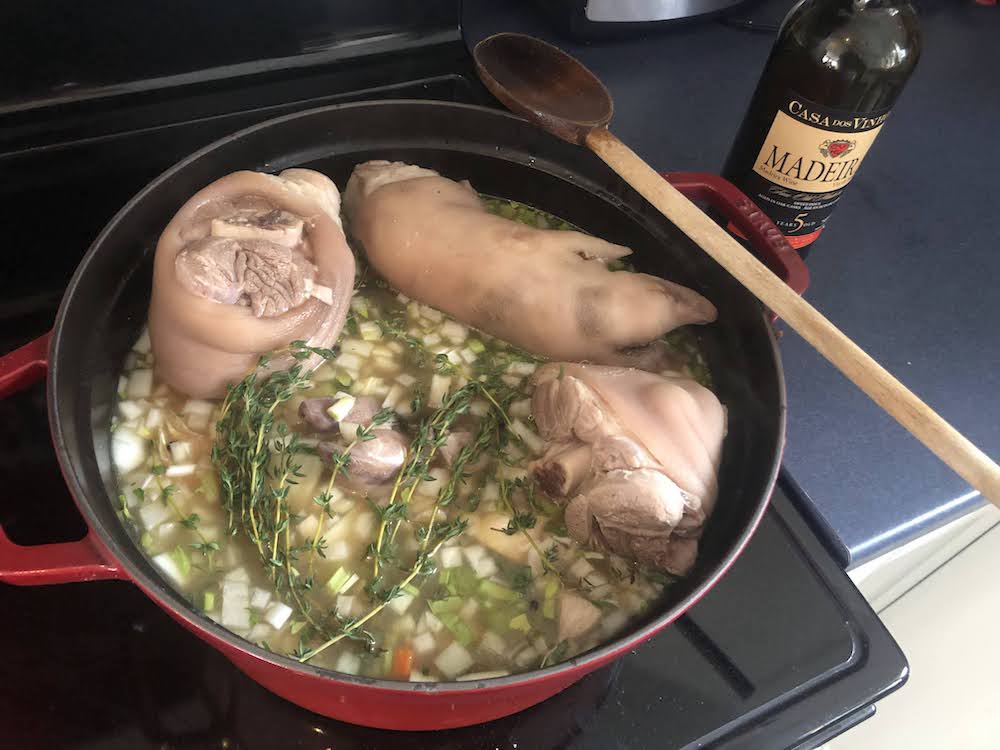
After three and a half hours your kitchen, and most likely the rest of your abode, should be smelling mighty fine. Well, to be fair, that’s only if you happen, like me, to enjoy the smell of boozy braised pig extremities. Admittedly it’s quite a forceful pong that’s certainly not for everyone.
Strain off the cooking liquid and set aside to cool. Meanwhile, pick out the pig bits, and pull off the meat from the hocks. I burned myself quite badly doing this, so I’ll advise you to let them cool off a little, as the residual heat contained within can be pretty brutal.
Take the trotters and strip them of their gelatinous skin. At this point you’ll see if you did a decent job burning off the bristles, as they will be most apparent if your work was shoddy. You’ll probably be best to discard any skin that still has bristles. This process reminds me of the time I prepared pork belly and mistakenly left on two distinctly hairy nipples; those didn’t go down too well. Ah well…
You won’t find much meat on the trotters, most of the collagen goodness will be in the cooking liquid by now, but strip off any edible bits you find. Discard the bones and knuckles from the hocks and trotters respectively.
Shred the meat by hand and slice the skin into thin slivers with a sharp knife. Add all of this to the cooking liquid and allow to cool to room temperature before filling sterlised mason jars with your gorgeous “Trotter Gear”. It’s a delight to look at, with shredded piggy bits suspended in a delightfully tasty jelly, like insects in amber.
I’m still experimenting with how long this stuff keeps for, but if you canned it correctly I’m guessing it will be perfectly good for quite some time.
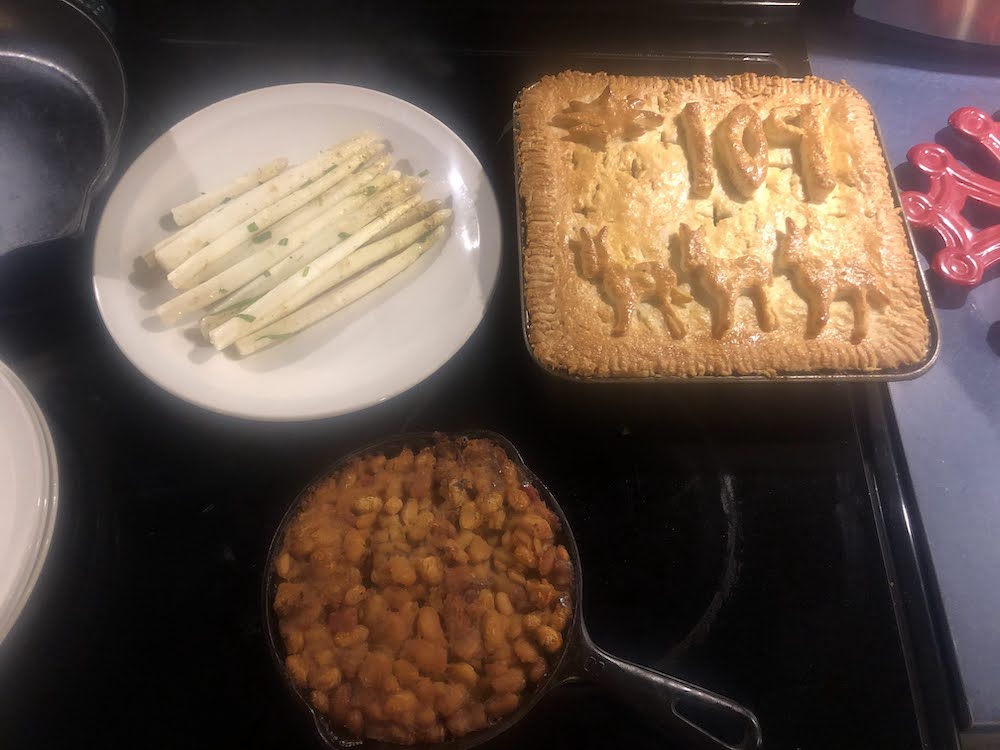
As I had part cooked so many beans earlier, I added one large mason jar of Trotter Gear to the pot of beans. Into this I then introduced two cans of chopped tomatoes, one small can of tomato purée, a handful of brown sugar, two cups of molasses, a good splashing of Worcester sauce, and salt and pepper. I let this slowly simmer for around an hour, occasionally stirring and allowing some of the beans to fall apart.
To serve I took a cast iron pan, and layered beans with two layers of cooked jowel bacon, baking them in the oven until the beans browned on top.
Absolutely fantastic, and better than any bean dish I have ever had previously.
My freezer is now full of enough trottered and hocked beans to last me and our son well into 2024.
My wife, on the other hand, just shakes her head and says “No, never”.

